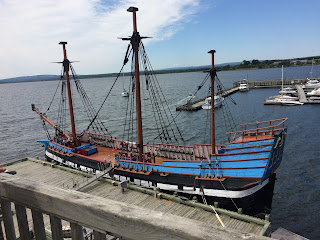 |
| Flag of Quebec |
I had some trepidation as we got underway from Pictou -- our next 3 ports were going to be in French-speaking Quebec. What good is a tour guide who can't speak your language to tell you what you're seeing? And I speak exactly zero French. I find all those silent letters intimidating (as I do with any word I learned while reading and don't want to use in conversation out of concern that I'll mispronounce it). I find the accent lovely to listen to, fluid and melodic, but again, intimidating and impossible to duplicate.
Trying to be prepared, I made myself a list of the most commonly asked questions aboard -- things like when the ship was built, how many crew, and where we are going next. Then I had a serious session with Google Translate and headphones to translate the answers into French. The questions, too, so I could recognize what was being asked, and then I wrote a phonetic shortcut to memorize what to say in response. And what I feared would become my most-used phrase: "Sorry, I don't speak French. Do you speak English or Spanish?"
My first day in our first French-speaking port, Gaspe, turned out to be a day off, and I quickly found the local bar. "Beer" and "biere" sound about the same, BTW. A helpful bilingual waitress double-checked my translation. I'm not sure whether the tasty beer, the lovely setting, or her confirmation that I was saying what I intended was the most reassuring, but anyway I had a lovely afternoon. She also echoed what my French-speaking friends Margo and Karen had already told me: as long as you give it even half a try, people will be welcoming. And likely each group will have at least one person who speaks some English and can translate for the rest.
And that was indeed the way it happened. People were delightful, warm, and interested. (Why is it that French Canadians have such a terrible -- and sadly sometimes deserved -- reputation for rudeness, arrogance, and bad seamanship on the ICW, and yet were so gracious and welcoming when we visited their province?) I learned to swallow my "r" when I said "bonjour" or "bienvenue a bord" even though it hurt my throat by the end of the day. I also learned to count to three because so many people asked me to take their photo. I learned to speak slowly so one member of a group could translate for the others. When that failed, a lot of sign language was involved, Gestures, and laughter. People
wanted to connect with us,
wanted to understand, and made it happen. And really, in their questions and interests they were more similar than different to people we'd met throughout the U.S. Makes sense, of course, if you give it half a thought. We are both nations of immigrants.
 |
| Talk about a warm welcome -- we were docked next to a vessel of the Canadian Coast Guard. They were too small and confined to offer below-deck tours to the public, but were glad to offer reciprocal tours to other crews. This lovely gentleman was their navigator, and as soon as he found out that I was learning to helm our ship, he proudly showed me the bridge of his. (Notice his quintessentially French beret. Most of this crew was fluent in both French and English.) |
 |
| We reciprocated with tours of El Galeon's engine room. |




















































